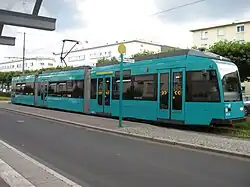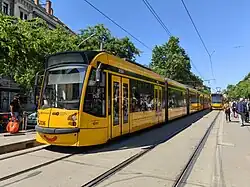Short-articulated tram


A short-articulated tram (German Kurzgelenkwagen)[1]: 7 [2][3] is a type of articulated tram. This tram type is carried on a single bogie in the center of each section.[4] These car sections are directly linked by a pivoting joint (articulation) and enclosed by protective bellows inside and outside and a cover plate on the floor. The sections may be controlled by rods and/or hydraulics. Alternatively with low-floor trams, this type is also termed Einzelgelekwagen;[1]: 7 and sometimes directly translated into single-articulated tram.[5][6] This term is the opposite of the multi-articulated tram.[7]
The need to build large tramcars can be seen in the development from two-axle cars to four-axle cars with two bogies. These four-axle cars were mostly 13 m to 15 m long; longer bodies would limit the usability in curves. Bigger trams needed an articulation resulting in six-axle trams with a Jacobs bogie, and around the same time, three section two-rooms-and-a-bath cars appeared. The first –with their three pivoting bogies– were expensive to build; the latter –having only two fixed bogies– were uncomfortable and caused additional wear of the rails. To cope with these problems, the "short-articulated tram" was developed.[1]: 6 The German word kurz (meaning "short") was applied because the inititial tramtypes were shorter than the six-axle cars. Over time, the "short-articulated tram" grew to about 20 m, almost the length of six-axle cars.[1]: 7
History
An early attempt to link sections directly resulted in the RETM tram 501/502. This tram with four fixed axles only ran from 1924 to 1928.[8] Due to its poor running characteristics, initially few models were replicated: a single test tram, such as the Ce160/162, was put on rails in Bern, Switzerland.[9] In Munich four four-axle trams were coupled in pairs in 1936/37, resulting in two eight-axle trams.[10]
Construction
Bremen Type
A prototype of this concept was built in Bremen in 1959.[11] These following series were locally called GT4, chronologically supplemented by a letter from the alphabet: GT4a through GT4f. Series a, b, and c were built in the 1960s, while series d, e, and f were a further development and were built in the 1970s.[12] These four-axle trams have better running characteristics than the pre-war articulated four-axle trams in other cities, because they are equipped with bogies instead of a fixed truck.

Progression
In 1965, a set of two prototypes for the Munich tram was delivered.[13][14] In the following years, series of trams were delivered (P2/3 motor cars and P2/3 trailers).[15] The Czech tram type Tatra KT4 was also constructed according to this concept, and in total 1,767 were built. The first protype (still having the body design of the Tatra T3) was tested in Prague in 1970.[1]: 26 Two prototypes (with the final body design) were sent to Potsdam in December 1974.[1]: 35
Low-floor trams
The city of Bremen also had the first low-floor version (from AEG/ADtranz in 1990, at the same time being the first fully low-foor tram.[16] The protype for Bremen had standard gauge bogies, it was the city of Augsburg to receive the first version with metre gauge bogies.[17] Munich and many other (primarily German) cities followed in later years.[18][19] As of 2025, this concept is still in use, although no longer by the original manufacturer, but by companies such as Siemens (Avenio),[6] Solaris,[20] Astra and CRRC.
Gallery
-
Two-section tram in Bremen
-
.jpg) Two-section tram in Galati
Two-section tram in Galati -
 Three-section tram in Frankfurt
Three-section tram in Frankfurt -
_HTM_Personenvervoer_Siemens_Avenio_No.5051_9_2025-06-05.jpg) Four-section tram in The Hague
Four-section tram in The Hague -
 Six-section tram in Budapest
Six-section tram in Budapest
See also
References
- ^ a b c d e f Köhler, Ivo (2009). KT 4 - der Kurzgelenkwagen aus Prag: D, SU, YU (in German). Ges. für Verkehrspolitik und Eisenbahnwesen. ISBN 978-3-89218-104-0.
- ^ "Die Geschichte der Bremer Straßenbahn". www.bsag.de (in German). Retrieved 30 July 2025.
- ^ "A rövid-csuklós villamosok". villamosok.hu (in Hungarian). Retrieved 30 July 2025.
- ^ Darter, Michael I.; Hamilton, Booz, Allen &; Hall, Kathleen Theresa; Kuo, Chen-Ming (1995). Applicability of Low-floor Light Rail Vehicles in North America. Transportation Research Board. p. 49. ISBN 978-0-309-05373-0.
{{cite book}}: CS1 maint: multiple names: authors list (link) - ^ Barrow, Keith (2012). "Electric Avenio". International Railway Journal. Retrieved 4 August 2025.
With Combino Plus, Siemens adopted the concept of the single-articulated vehicle, whereby each of the outer and intermediate sections has its own powered or unpowered bogie.
- ^ a b "Avenio low-floor trams". Siemens Mobility Global. Retrieved 4 August 2025.
- ^ Dellmann, Abdelfattah (May 2011). Multi-articulated vs. single-articulated vehicles Streetcar concepts in comparison.
- ^ "Motortrams in Nederland". NVBS (in Dutch). Retrieved 30 July 2025.
- ^ "Portrait Ce 2/4 160-162". www.tram-bus-bern.ch (in German). Retrieved 30 July 2025.
- ^ "A-Tw 256". trambahn (in German). Retrieved 30 July 2025.
- ^ "Fahrschultriebwagen 402". www.fdbs.net (in German). Retrieved 30 July 2025.
- ^ "Fahrschultriebwagen 548". www.fdbs.net (in German). Retrieved 30 July 2025.
- ^ Die Münchner Tram: Geschichte, Linien, Fahrzeuge (in German). GeraMond. 2010. pp. 107, 116. ISBN 978-3-86245-104-3.
- ^ "50 Jahre P-Wagen". Strassenbahn Magazin (in German). 2017 (11): 38–45.
- ^ "P-Triebwagen und p-Beiwagen". www.strassenbahn-muenchen.de (in German). Retrieved 30 July 2025.
- ^ Pyrgidis, Christos N. (31 October 2021). Railway Transportation Systems: Design, Construction and Operation. CRC Press. p. 133. ISBN 978-1-000-46283-8.
- ^ "Zagreb purchases Augsburg's GT6M low-floor trams". Urban Transport Magazine. 8 August 2023. Retrieved 4 August 2025.
- ^ "Triebwagen 801". Freunde der Bremer Straßenbahn e.V. (in German). Retrieved 30 July 2025.
- ^ "AllTransUA". alltransua.com. Retrieved 30 July 2025.
- ^ "Zwei Grundtypen an "Tramino"". Strassenbahn Magazin (in German). 2015 (07): 80.